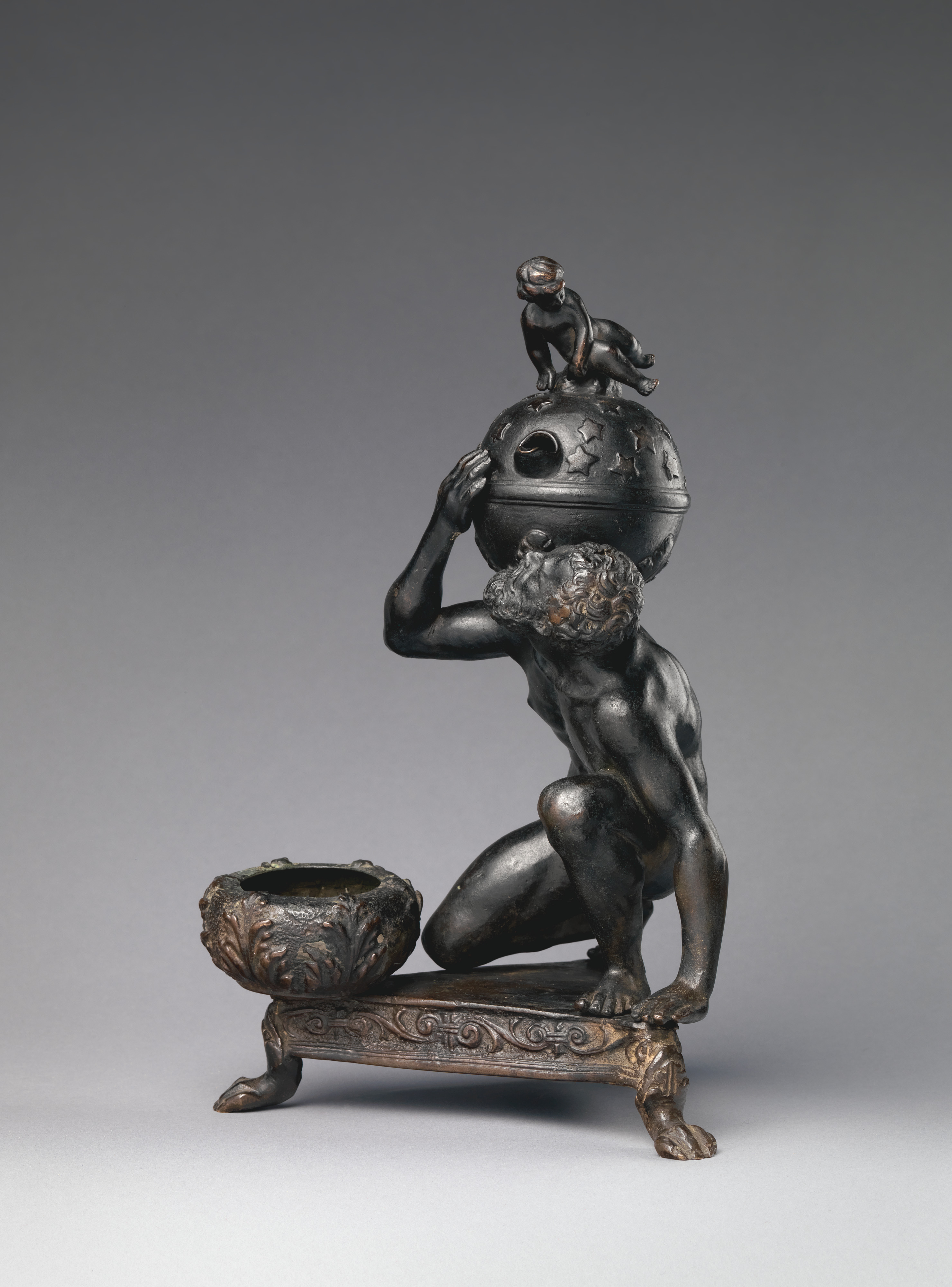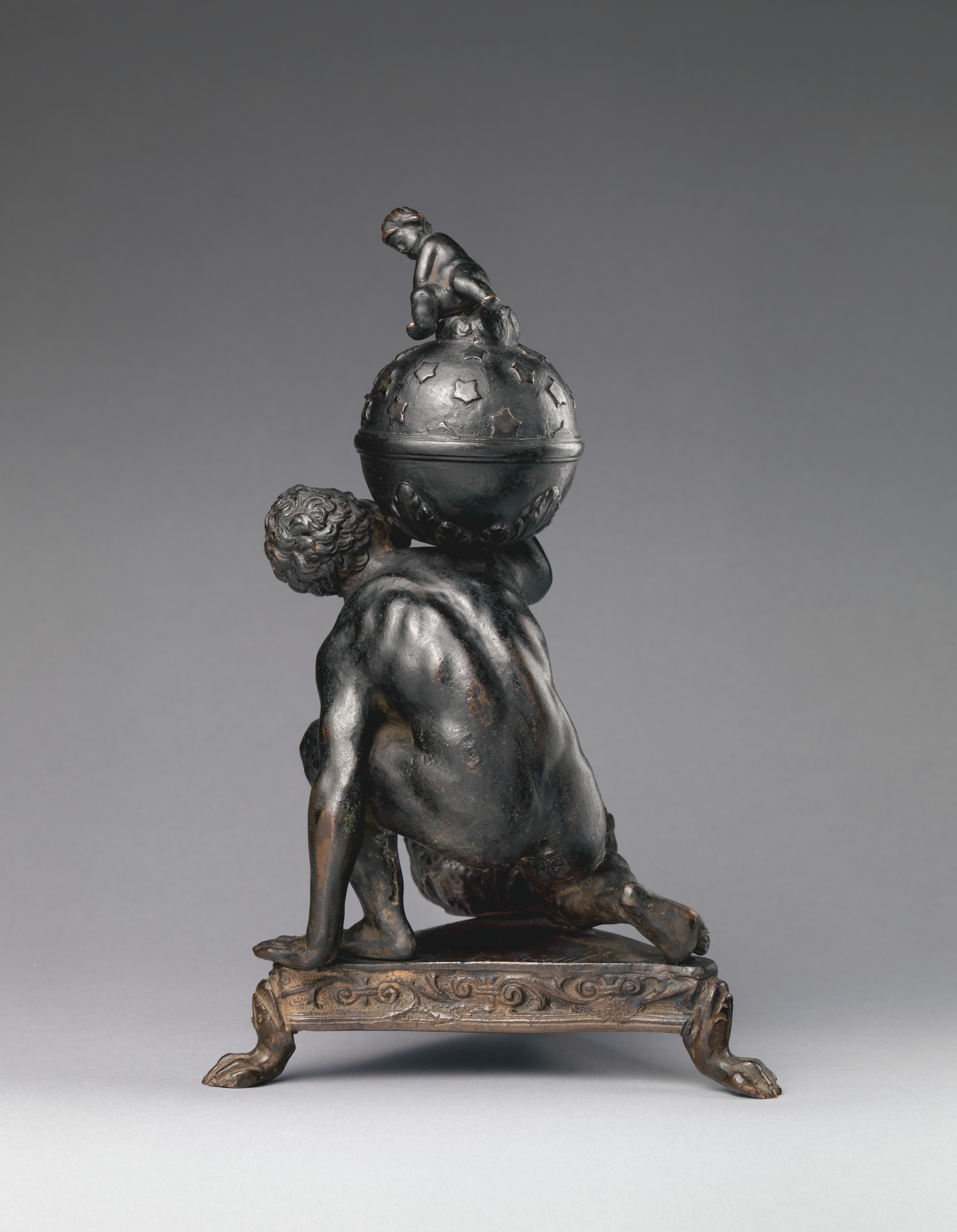Atlas Supporting the Globe
Workshop of Andrea Briosco, called Riccio Italian
Not on view
In 1926, The Met received a bequest from the late Annie C. Kane of more than 100 objects, mostly European decorative arts, that had adorned her Italian Renaissance–style McKim, Mead & White home on Fifth Avenue. When curator Joseph Breck published the Kane bequest the next year, he singled out this bronze for praise. It was one of only a handful of objects to be illustrated, with Breck highlighting its attribution to Riccio. Since then, the bronze has been nearly forgotten.
The neglect may have to do with its inferior quality, its makeup a heterogeneous array of disparate parts cast in different centuries and likely assembled in the nineteenth to satisfy a market for a popular composition. Indeed, at least twenty examples of this or similar compositions are known: a kneeling Atlas supporting a globe, surmounted by a small child, a utilitarian object that in its most complete state (the exquisite bronze today in the Frick) functioned as an inkwell and oil lamp.[1]
The early attribution of these bronzes to Riccio, proposed by Leo Planiscig, has since been abandoned in favor of an association with Severo da Ravenna and his workshop. The reasons for the link to Severo include the similarity between Atlas’s pose and known kneeling figures by the artist, technical characteristics of the best versions, which align with his workshop practice, and the Veneto-friendly subject matter. Charles Avery has drawn a connection between the bronze figures of Atlas and the ancient marble Ercole Orario, since destroyed but the subject of intense antiquarian interest in Ravenna at the end of the quattrocento.[2]
According to Richard Stone, only the triangular base of The Met’s bronze might have something to do, if distantly, with Severo’s workshop, and is likely the only component that should be dated to the sixteenth century.[3] The figure of Atlas is crudely modeled, with little detailing in the modeling or finishing. The inkpot that screws into the base, likely a nineteenth-century product, is of poor quality, with thin uneven walls yielding holes in certain areas; it could scarcely have held any actual ink. The globe atop Atlas’s shoulders, rather schematic in its simplistic ornamentation, also appears nineteenth century in its manufacture, and is nonfunctional despite its putative purpose as an oil lamp (by contrast, the globe on the Frick bronze can be opened for refilling). Puzzlingly, the small child playfully posed on the globe was once gilded.
-JF
Footnotes
(For key to shortened references see bibliography in Allen, Italian Renaissance and Baroque Bronzes in The Metropolitan Museum of Art. NY: The Metropolitan Museum of Art, 2022.)
1. See C. Avery 1998b, p. 92, no. 52, for a list of seventeen variants, to which should be added the present example and a superior version also in The Met Lehman Collection (1975.1.1399), for which see Scholten 2011 pp. 30–32, no. 14. For the Frick bronze (1915.2.24), see Pope-Hennessy 1970, pp. 106–11.
2. C. Avery 1998b, p. 92.
3. The alloy of the base is a lightly leaded brass that is typical of Severo’s shop practice, and the hole for attachment of the inkpot has typical Severan threads. In contrast, the figure of Atlas is a leaded bronze, and the globe and its surmounting putto contain substantial amounts of tin. There are also distinct differences in the surface finish on separate elements, including traces of oil gilding on the putto. R. Stone/TR, May 15, 2008.
Due to rights restrictions, this image cannot be enlarged, viewed at full screen, or downloaded.
This artwork is meant to be viewed from right to left. Scroll left to view more.




